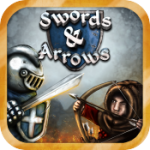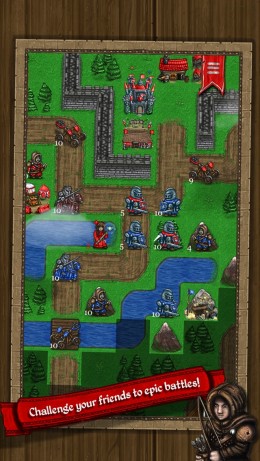 It has always struck me as odd, given how many homages and even outright clones there are of popular Nintendo franchises on iOS, how few games there are that are similar to Advance Wars. With gameplay well-suited to touch controls, a pace that lends itself well to short bursts of play, and multiplayer that seems a good match for asynchronous play, one would think we’d be up to our elbows in similar games. Yet, apart from the truly great Great Big War Game ($2.99) and the now-defunct Uniwar and Mecho Wars, it’s not easy to find games that give the same sort of feeling as playing Advance Wars. Today, we can add another game to the list, and except in setting, Swords & Arrows (Free) probably hews the closest yet to that classic.
It has always struck me as odd, given how many homages and even outright clones there are of popular Nintendo franchises on iOS, how few games there are that are similar to Advance Wars. With gameplay well-suited to touch controls, a pace that lends itself well to short bursts of play, and multiplayer that seems a good match for asynchronous play, one would think we’d be up to our elbows in similar games. Yet, apart from the truly great Great Big War Game ($2.99) and the now-defunct Uniwar and Mecho Wars, it’s not easy to find games that give the same sort of feeling as playing Advance Wars. Today, we can add another game to the list, and except in setting, Swords & Arrows (Free) probably hews the closest yet to that classic.
 Swords & Arrows is a medieval fantasy turn-based strategy game that wears its inspiration on its sleeve proudly. The objective of each battle is, ultimately, to capture the enemy castle(s), but it’s really more of a game about seizing and controlling resources. Let’s get the biggest fault of the game out of the way immediately: this is multiplayer only. You can play with up to five other players asynchronously over the internet or you can pass and play with someone in the same room, but unless you’re Harman Smith, you’ll need at least two people to enjoy this one. The developer has said he hopes to include AI or a campaign at some point, but for now, all you get is multiplayer.
Swords & Arrows is a medieval fantasy turn-based strategy game that wears its inspiration on its sleeve proudly. The objective of each battle is, ultimately, to capture the enemy castle(s), but it’s really more of a game about seizing and controlling resources. Let’s get the biggest fault of the game out of the way immediately: this is multiplayer only. You can play with up to five other players asynchronously over the internet or you can pass and play with someone in the same room, but unless you’re Harman Smith, you’ll need at least two people to enjoy this one. The developer has said he hopes to include AI or a campaign at some point, but for now, all you get is multiplayer.
With that said, the multiplayer in this game is very fun. You start off with some gold, a castle, and some number of other buildings to your name. Each building has a particular effect. The castle is used to train new units or research perks to use in the current battle. Barracks can also be used to train new units, but only the basic ones. Towns and mines put cash in your coffers every turn, with towns having the added effect of healing any injured units placed on them, and the blacksmith can speed up your research for a price. You cannot build these buildings yourself. They are fixed in their locations on the map, and can only be captured, not destroyed. The battle ends when you capture all of your opponents’ castles, a move which can only be performed by the humble swordsman, your most basic unit.
Your basic units, which can be created at either a barracks or a castle, include the swordsman, whose ability to capture buildings makes up for his relative weakness in combat, the bowman, who can attack at a distance but has weak defense, and the knight, a powerful mounted unit whose movement is heavily restricted by the terrain. In addition to these basic units, two advanced units can be created at your castle. The mage can’t attack, but she can heal her allies. The catapult is, as you might expect, devastatingly powerful, which is compensated for by its high cost and limited mobility. In addition, its shots will hit all adjacent squares of the target, so it’s easy to damage your own units if you aren’t paying attention. It’s not a large cast, but they’re well-balanced, and each has something different to offer on each of the many maps. For example, knights are incredibly useful on open maps, and virtually useless on mountainous ones.
 There are more than 40 maps of various sizes to choose from, giving you a good selection for any number of players you might have. Terrain is extremely important in this game, and the selection of maps really takes advantage of that to provide a huge variety of scenarios. Depending on the type of terrain, tiles on the map will convey bonuses to sight or defense, impede movement, or outright block units from passing. Equally important on each map is the distribution of resources and neutral buildings. Capturing and holding these locations is absolutely crucial to your victory. Most of the maps lay them out fairly symmetrically, but some maps create siege-type scenarios which are great for a change of pace. If you can’t find anything you like, you can go ahead and make maps yourself with the game’s built-in editor.
There are more than 40 maps of various sizes to choose from, giving you a good selection for any number of players you might have. Terrain is extremely important in this game, and the selection of maps really takes advantage of that to provide a huge variety of scenarios. Depending on the type of terrain, tiles on the map will convey bonuses to sight or defense, impede movement, or outright block units from passing. Equally important on each map is the distribution of resources and neutral buildings. Capturing and holding these locations is absolutely crucial to your victory. Most of the maps lay them out fairly symmetrically, but some maps create siege-type scenarios which are great for a change of pace. If you can’t find anything you like, you can go ahead and make maps yourself with the game’s built-in editor.
Learning to play is pretty easy, and in-game tips will teach you about a lot of the less obvious nuances. This is not the most complicated turn-based strategy game on the App Store by any means, but that’s part of its appeal. It’s immediately accessible, but with enough depth to allow for all kinds of interesting strategies. I genuinely feel an opportunity has been missed with the lack of any sort of single player component, and I would love to see more unit types, but what’s here is very good, particularly keeping in mind the agreeable price. It’s definitely worth your time to check out if you’re into strategy games, but even if you’re not, you might want to give it a try. If you need some opponents to get you on your way, head to the thread in our forums. Swords & Arrows, like the game it pays homage to, is an easy-to-pick up, fun way to wage war with your friends, and it’s quite welcome in my software library anytime.